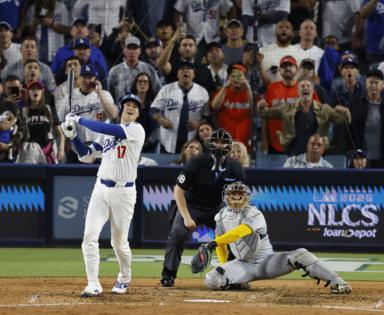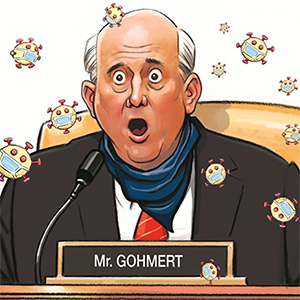Paul Sullivan: How does Shohei Ohtani's feat stack up against the greatest postseason performances of all time?
Published in Baseball
CHICAGO — Michael Jordan versus LeBron James is a debate so old school, you almost need to be in a barbershop chair to fully engage.
But anyone can be an instant expert on the latest great debate: Jordan versus Shohei Ohtani. Who had the greatest individual postseason performance in North American sports history?
Or is it Ohtani versus Reggie Jackson?
Or Elgin Baylor? Mark Messier? Steve Young?
Insert your own legend.
The beauty of sports arguments is no one can definitely prove they’re right. But Ohtani’s three-homer performance with six shutout innings and 10 strikeouts has opened the door to all comers.
While the World Series between the Los Angeles Dodgers and Toronto Blue Jays begins Friday at Rogers Centre, the smoke has yet to clear on Ohtani’s performance last Friday at Dodger Stadium in his team’s Game 4 NLCS win over the Milwaukee Brewers.
It was referred to as the greatest individual performance in team sports history, but an asterisk is necessary because there is no one quite like Ohtani, the only baseball player who’s an All-Star as both a pitcher and a hitter. Babe Ruth is the only fair comparison, and he pitched in only three postseason games in two World Series for the Boston Red Sox.
My two closest picks for having an Ohtani-esque postseason game are Jordan and Jackson. NHL and NFL comparisons are simply harder to make.
An NHL player can’t score goals and also be the team’s goaltender, so it really would be up to a goal scorer to make the comparison. Mark Messier famously recorded a hat trick for the New York Rangers after guaranteeing a win over the New Jersey Devils in Game 6 of the 1994 Eastern Conference finals, but was that really Ohtani-like?
NFL postseason heroics are even more difficult to compare with the Ohtani legend. Philadelphia Eagles linebacker Chuck Bednarik, who also played center, was the last great two-way NFL player, but he retired in 1962, before the Super Bowl era. The only current player who could pull an Ohtani is Jacksonville Jaguars rookie wide receiver/cornerback Travis Hunter, who isn’t a star at either position yet, played only 12 defensive snaps last week and obviously hasn’t played in a postseason game.
A great quarterback performance would have to suffice as the comparison. Steve Young threw a record six touchdown passes in the San Francisco 49ers’ win over the San Diego Chargers in Super Bowl XXIX, but Tom Brady’s 466 yards and two touchdowns in the New England Patriots’ comeback win over the Atlanta Falcons in Super Bowl LI might be the more impressive feat.
Still, neither was Ohtani-level brilliance.
Jordan’s 63-point effort for the Chicago Bulls in a 135-131 double-overtime loss to the Boston Celtics in Game 2 of their 1986 first-round series at Boston Garden set a postseason record that still stands.
“I think he’s God disguised as Michael Jordan,” Celtics star Larry Bird said afterward. “He is the most awesome player in the NBA. Today in Boston Garden, on national TV, in the playoffs, he put on one of the greatest shows of all time.”
Jordan’s 63 points beat the previous postseason scoring record of 61 set by the Los Angeles Lakers’ Elgin Baylor against the Celtics in a 126-121 win in Game 5 of the 1961 NBA Finals.
Baylor went 26 of 46 from the field and 17 of 19 from the line while being defended by Tom “Satch” Sanders and Bill Russell inside. Wilt Chamberlain had set the scoring record with a 56-point playoff game for the Philadelphia Warriors three weeks earlier.
Hall of Fame NBA writer Sam Smith believes Baylor’s 61-point, 22-rebound game trumps Jordan’s 63 because it came in the Finals, not in the first round. Jordan also needed two overtimes to get 63, while Baylor did it by playing all 48 regulation minutes.
Some also might disqualify Jordan’s 63 as the “best ever” because it came in a loss. Jordan missed a 15-footer with three seconds left in the first overtime that would’ve won it for the Bulls, who eventually were swept in the series. The Celtics came back to win the last two games of the 1961 Finals — and the fourth of their 11 championships in 13 years — but Baylor’s 61 remains a Finals record 64 years later.
Baseball is the easiest comparison, of course, even though Ohtani is the unicorn.
Dozens of pitchers have had better postseason outings than Ohtani, most notably Don Larsen’s perfect game for the New York Yankees against the Dodgers in Game 5 of the 1956 World Series. It’s the three home runs that made Ohtani’s performance special.
A major league player has homered three times in a postseason game on only 13 occasions, including Ruth twice. Only three others have done it in a World Series: Jackson, the St. Louis Cardinals’ Albert Pujols (2011) and the San Francisco Giants’ Pablo Sandoval (2012).
Jackson’s performance stands out to this day. His three-homer game for the Yankees against the Dodgers in the clinching Game 6 of the 1977 World Series sealed his reputation as “Mr. October” and was considered the greatest offensive performance in a World Series since Ruth. Each home run was hit on the first pitch.
“His was the most lurid performance in 74 World Series,” legendary New York columnist Red Smith wrote of Jackson that night. “For although Babe Ruth hit three home runs in a game in 1926, and again in 1928, not even that demigod smashed three in a row.”
Smith noted that Jackson had homered in his final at-bat in Game 5 in Los Angeles, then walked in his first at-bat in Game 6, giving him four home runs in four official at-bats. In a span of nine World Series at-bats, Jackson had six hits, five home runs and six RBIs, leading Smith to write, “Shakespeare wouldn’t attempt a curtain scene like that if he was plastered.”
Sam Smith, who covered Game 6 as a young sports writer and watched Ohtani’s feat on TV, said Jackson’s night “felt more dramatic” than Ohtani’s because it was a World Series clincher and part of a classic rivalry. Ohtani’s feat came in an inevitable Game 4 sweep of the Brewers in a National League Championship Series. It doesn’t lessen the performance, but it wasn’t as big a game.
“There was more pressure on Reggie, being in Yankee Stadium and being in Game 6 of the Series,” Smith said. “Obviously (Ohtani’s) combo of (home runs) and the pitching was superior to Reggie’s night.”
Ruth’s three World Series pitching outings, all with the Red Sox, came before he turned into a full-time position player with the Yankees. His most Ohtani-like pitching performance was in Game 2 of the 1916 World Series, in which he allowed one run in 14 innings in the Red Sox’s 2-1, 14-inning win over the Brooklyn Robins. Ruth got the win but went 0 for 5 at the plate, so it wasn’t close to an Ohtani.
Ruth also won two games for the Red Sox against the Chicago Cubs in the 1918 World Series. But he went 0 for 3 in Boston’s 1-0 win in Game 1 at Comiskey Park (where the Cubs played their home games in the ’18 Series) and had a two-run triple while allowing two runs in eight innings in a 3-2 Game 4 win at Fenway Park.
“Babe Ruth lived up to his lithographs,” Tribune baseball writer I.E. Sanborn wrote from Boston.
For Gen Z readers, that’s comparable to Ohtani “living up” to his shoe commercial slogan, “We got now,” in modern-day baseball.
Ohtani likely will get another chance to etch his name at the top of all arbitrary sports debates when he makes his World Series pitching debut against the Blue Jays. Dodgers manager Dave Roberts hasn’t announced his starters past Games 1 and 2, but he knows everyone wants to see his $700 million superstar on the mound.
Can the demigod do it again in the Fall Classic?
Can’t wait to find out.
©2025 Chicago Tribune. Visit chicagotribune.com. Distributed by Tribune Content Agency, LLC.







Comments